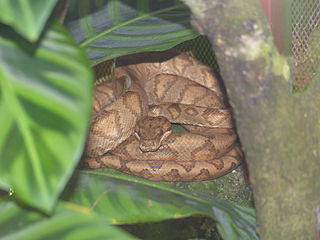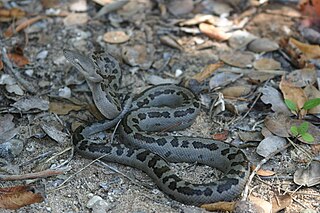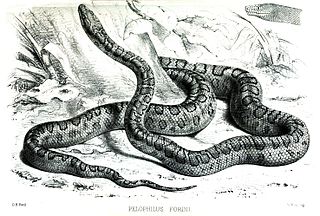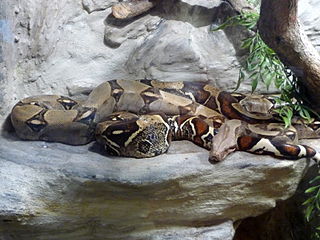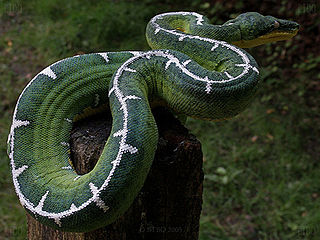| Boinae | |
|---|---|
 | |
| Boa constrictor (Boa constrictor) | |
| Scientific classification | |
| Kingdom: | |
| Phylum: | |
| Class: | |
| Order: | |
| Suborder: | |
| Family: | |
| Subfamily: | Gray, 1825 |
This is a list of all extant genera, species and subspecies of the snakes of the subfamily Boinae , otherwise referred to as boines or true boas. It follows the taxonomy currently provided by ITIS, [1] which is based on the continuing work of Roy McDiarmid. [2]
- Boa , true boas sensu stricto
- Boa constrictor, boa constrictor or red-tailed boa
- Boa constrictor constrictor , red-tailed boa constrictor or red-tailed boa
- Boa constrictor longicauda , long-tailed boa constrictor or long-tailed boa
- Boa constrictor occidentalis , Argentine boa constrictor or Argentine boa (also known locally as ampalagua, lampalagua or boa de las vizcacheras) [3]
- Boa constrictor ortonii , Orton's boa constrictor or Orton's boa
- Boa imperator , Central American boa, northern boa or Colombian boa
- Boa imperator imperator , Central American boa, northern boa or Colombian boa
- Boa imperator sabogae , Pearl Islands boa
- Boa nebulosa , Dominican boa
- Boa orophias , Saint Lucia boa
- Boa sigma , Mexican west coast boa
- Boa constrictor, boa constrictor or red-tailed boa
- Chilabothrus , West Indian boas or Greater Antillean boas
- Chilabothrus ampelophis
- Chilabothrus angulifer, Cuban boa or Cuban tree boa
- Chilabothrus argentum, Conception Bank silver boa, Conception Bank boa or silver boa
- Chilabothrus chrysogaster , Turks and Caicos Islands boa or Southern Bahamas boa
- Chilabothrus chrysogaster chrysogaster , Turks and Caicos Islands boa
- Chliabothrus chrysogaster relicquus , Great Inagua boa
- Chilabothrus exsul , Abaco Islands boa or Northern Bahamas boa
- Chilabothrus fordii , Ford's boa or Hispaniolan desert boa
- Chilabothrus fordii agametus , Môle Saint Nicholas boa
- Chilabothrus fordii fordii , Ford's boa or Hispaniolan desert boa
- Chilabothrus fordii manototus , Île à Caprit boa
- Chilabothrus gracilis , Hispaniolan vine boa
- Chilabothrus gracilis gracilis , Dominican Republic vine boa
- Chilabothrus gracilis hapalus , Tiburon Peninsula vine boa
- Chilabothrus granti , Virgin Islands boa
- Chilabothrus inornatus, Puerto Rican boa
- Chilabothrus monensis, Mona Island boa
- Chilabothrus schwartzi , Crooked-Acklins boa
- Chilabothrus striatus , Hispaniolan boa or Haitian boa
- Chilabothrus striatus exagistus , Tiburon Peninsula boa
- Chilabothrus striatus striatus , Hispaniolan red mountain boa or Dominican red mountain boa
- Chilabothrus striatus warreni , Île de la Tortue boa
- Chilabothrus strigilatus , Bahamian boa
- Chilabothrus strigilatus ailurus , Cat Island boa
- Chilabothrus strigilatus fosteri , Bimini boa
- Chilabothrus strigilatus fowleri , Andros boa
- Chilabothrus strigilatus mccraniei , Ragged Island boa
- Chilabothrus strigilatus strigilatus , Bahamian boa
- Chilabothrus subflavus, Jamaican boa, Jamaican yellow boa or yellow snake
- Corallus , neotropical tree boas
- Corallus annulatus , annulated tree boa or ringed tree boa
- Corallus annulatus annulatus , northern annulated tree boa or northern ringed tree boa
- Corallus annulatus colombianus , Colombian annulated tree boa or Colombian ringed tree boa
- Corallus batesii , Amazon Basin emerald tree boa
- Corallus blombergi , Ecuadorian annulated tree boa or Blomberg's tree boa
- Corallus caninus, emerald tree boa
- Corallus cookii , Cook's tree boa
- Corallus cropanii , Cropani's tree boa
- Corallus grenadensis , Grenada tree boa or Grenada Bank tree boa
- Corallus hortulanus , Amazon tree boa, garden tree boa or macabrel
- Corallus ruschenbergerii , Central American tree boa or Trinidad tree boa
- Corallus annulatus , annulated tree boa or ringed tree boa
- Epicrates , rainbow boas
- Epicrates alvarezi , Argentinian rainbow boa
- Epicrates assisi , Caatinga rainbow boa
- Epicrates cenchria, rainbow boa
- Epicrates cenchria barbouri , Marajo Island rainbow boa
- Epicrates cenchria cenchria , Brazilian rainbow boa
- Epicrates cenchria gaigei , Peruvian rainbow boa
- Epicrates cenchria hygrophilus , Espirito Santo rainbow boa
- Epicrates cenchria polylepis , Central Highlands rainbow boa
- Epicrates crassus , Paraguayan rainbow boa
- Epicrates maurus , brown rainbow boa
- Eunectes , anacondas
- Eunectes beniensis , Bolivian anaconda or Beni anaconda
- Eunectes deschauenseei , dark-spotted anaconda or De Schauensee's anaconda
- Eunectes murinus, green anaconda
- Eunectes notaeus, yellow anaconda






